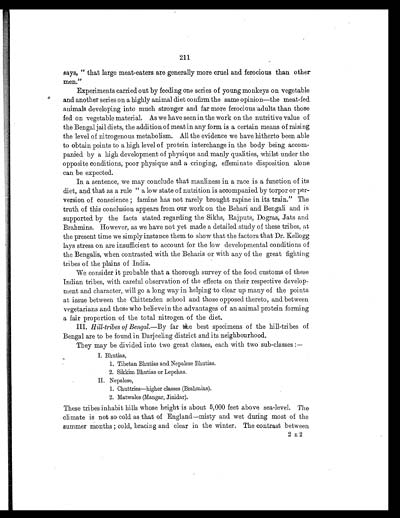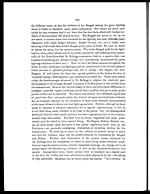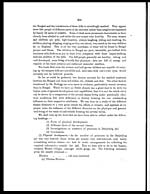Medicine - Institutions > Army health reports and medical documents > Scientific memoirs by officers of the Medical and Sanitary Departments of the Government of India > Number 37 - Investigations on Bengal jail dietaries > Part II > Relationship of food to physical development
(221) Page 211
Download files
Individual page:
Thumbnail gallery: Grid view | List view

211
says, "that large meat-eaters are generally more cruel and ferocious than other
men."
Experiments carried out by feeding one series of young monkeys on vegetable
and another series on a highly animal diet confirm the same opinion—the meat-fed
animals developing into much stronger and far more ferocious adults than those
fed on vegetable material. As we have seen in the work on the nutritive value of
the Bengal jail diets, the addition of meat in any form is a certain means of raising
the level of nitrogenous metabolism. All the evidence we have hitherto been able
to obtain points to a high level of protein interchange in the body being accom-
panied by a high development of physique and manly qualities, whilst under the
opposite conditions, poor physique and a cringing, effeminate disposition alone
can be expected.
In a sentence, we may conclude that manliness in a race is a function of its
diet, and that as a rule "a low state of nutrition is accompanied by torpor or per-
version of conscience; famine has not rarely brought rapine in its train." The
truth of this conclusion appears from our work on the Behari and Bengali and is
supported by the facts stated regarding the Sikhs, Rajputs, Dogras, Jats and
Brahmins. However, as we have not yet made a detailed study of these tribes, at
the present time we simply instance them to show that the factors that Dr. Kellogg
lays stress on are insufficient to account for the low developmental conditions of
the Bengalis, when contrasted with the Beharis or with any of the great fighting
tribes of the plains of India.
We consider it probable that a thorough survey of the food customs of these
Indian tribes, with careful observation of the effects on their respective develop-
ment and character, will go a long way in helping to clear up many of the points
at issue between the Chittenden school and those opposed thereto, and between
vegetarians and those who believein the advantages of an animal protein forming
a fair proportion of the total nitrogen of the diet.
III. Hill-tribes of Bengal.—By far the, best specimens of the hill-tribes of
Bengal are to be found in Darjeeling district and its neighbourhood.
They may be divided into two great classes, each with two sub-classes :—
I. Bhutias,
1. Tibetan Bhutias and Nepalese Bhutias.
2. Sikkim Bhutias or Lepchas.
II. Nepalese,
1. Chuttries—higher classes (Brahmins).
2. Matwales (Mangar, Jinidar).
These tribes inhabit hills whose height is about 5,000 feet above sea-level. The
climate is not so cold as that of England—misty and wet during most of the
summer months; cold, bracing and clear in the winter The contrast between
2 E 2
Set display mode to: Large image | Zoom image | Transcription
Images and transcriptions on this page, including medium image downloads, may be used under the Creative Commons Attribution 4.0 International Licence unless otherwise stated. ![]()
| Permanent URL | https://digital.nls.uk/75033378 |
|---|




